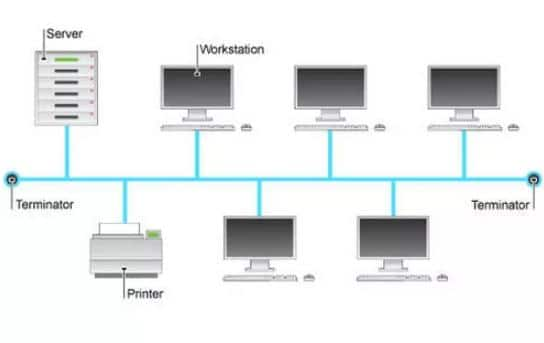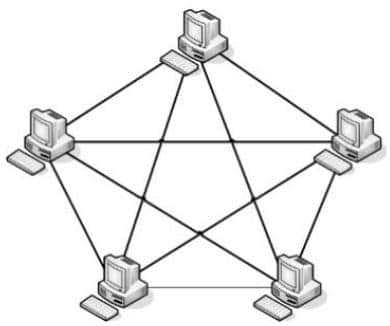Understanding Network Topology
Computer network topology is a method or method used to connect one computer to another computer. The structure or network used to connect one computer to another can be wired or wireless (without cables).
Computer Network Topology Functions
Computer network topology functions to find out how each computer or host in a computer network can communicate with each other.
Types of Computer Network Topology and Their Strengths and Weaknesses
1. Ring topology
Ring topology or often called ring topology is a type of network topology that is used to connect a computer to another computer in a circular circuit like a ring. Generally, this type of ring network topology only uses a LAN card so that each computer is connected. Ring Topology Picture :
The advantages of ring topology include :
- The installation fee is cheap.
- Connection performance is quite good.
- The installation and configuration process is quite easy.
- Its implementation is easy.
Disadvantages of Ring Topology, including :
- If a problem occurs, network troubleshooting is somewhat complicated.
- Very vulnerable to data flow collisions.
- If one connection has a problem, the connection on the network will be lost.
2. Bus Topology
The bus topology is a simpler network topology. In general, this network topology is carried out on coaxial cable-based network installations. The bus topology uses coaxial cable along the client nodes and connectors. The connector types used are BNC, Terminator, and TBNC. Bus Topology Picture :
The advantages of Bus Topology, including :
- Adding new clients or workstations is easy.
- Easy to use and very simple.
- Low installation costs because the cables used are few.
Disadvantages of Bus Topology, including :
- Data flow collisions often occur.
- The process of sending and receiving data is less efficient.
- The old bus topology is difficult to extend.
- If there is a problem with the cable, for example it is disconnected, the workstation computer will be disrupted.
3. Mesh Topology
Mesh topology is a topology that can be used for many routes. This topology network uses a single cable so that the data transmission process becomes faster without going through a hub or switch. Mesh Topology Picture :
The advantages of the Mesh Topology include :
- The bandwidth limit is quite large.
- Data security in this topology is very good.
- There is no data flow collision because there are so many data transmission paths.
Disadvantages of Mesh Topology, including :
- A large number of cables are needed.
- The cost of installing a mesh topology is very expensive because it uses a lot of cables.
- The installation is very complicated.
4. Star topology
Star topology or also called star topology is a star-shaped network topology which generally uses a hub or switch for connections between clients. This computer network topology is most often used today because it has many advantages. Star Topology Image :
The advantages of star topology include :
- This network topology continues to run well even though one of the client computers has a problem.
- The level of data security in this topology is quite good.
- Users more easily detect problems on the network.
- More flexible.
Disadvantages of Star Topology, including :
- This topology is considered expensive because it uses quite a lot of cables.
- All computers in this network will have problems if the hub or switch has a problem.
- Very dependent on the central terminal.
5. Tree topology
Tree topology or tree topology is the result of a combination of bus topology and star topology. Generally, tree topology is used for interconnection between hierarchies with different centers. Tree Topology Image :
The advantages of tree topology include :
- Can and easily be developed into a wider network topology.
- This topological arrangement is hierarchically centralized so that data management becomes easier.
Disadvantages of Tree Topology, including :
- Has slow network performance.
- The use of cables is very much so that the installation costs are expensive.
- Backbone cable is the center of this topology.
- If the top computer has a problem, then the bottom computer will also have a problem.
6. Peer to Peer Topology
Peer to peer topology is a very simple network topology because it only connects 2 computers. Generally, peer to peer topology uses just one cable to connect the two computers so that they can share data with each other. Picture of Peer to Peer Topology:
The advantages of Peer to Peer Topology, including :
- Installation costs are very cheap.
- Easy installation process.
- Each computer can act as a server or client.
Disadvantages of Peer to Peer Topology, including :
- Very difficult to develop.
- Security in this topology is often problematic.
- The troubleshooting process is complicated.
7. Linear Topology
Linear topology or often referred to as sequential bus topology. In general, this topology only uses one main cable as a connector for each connection point on each computer. Linear Topology Picture :
The advantages of Linear Topology, including :
- Easy to develop.
- Little cable use.
- Simple and easy linear topology layout.
- This topology does not require central control.
Disadvantages of Linear Topology, including namely :
- Data traffic density is quite high.
- Data security is not guaranteed.
8. Hybrid Topology
Hybrid topology is a combination of several different topologies and forms a new network. In other words, if there are two or more different topologies connected in one network, the network topology will form a hybrid topology. Hybrid Topology Picture :
The advantages of Hybrid Topology, including :
- Be flexible.
- Adding other connections to this topology is very easy.
Disadvantages of Hybrid Topology, including :
- The installation and setup process is quite complicated.
- Hybrid topology management is very difficult to do.
- The cost to create this topology is quite expensive.









Tidak ada komentar:
Posting Komentar